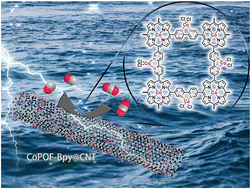A supported polymeric organic framework composed of dual electrocatalytically active sites for high-performance carbon dioxide electroreduction†
Abstract
The electrocatalytic reduction of CO2 to CO and other sustainable fuels presents an attractive approach for alleviating the energy crisis and environmental problems. Carbon nanotube (CNT) hybridization and the incorporation of dual catalytic sites into a polymeric organic framework (POF) are promising strategies for boosting the electrocatalytic performance of POF-tailored electrocatalysts. Herein, we demonstrate a combined nanoscale and molecular-level strategy to construct an organic–inorganic hybrid material by the template-directed in situ polymerization of ultrathin POF layers with isolated Co(II) porphyrin (Por-) and Co(II) bipyridine sites on the CNT scaffold. As an electrocatalyst for CO2-to-CO conversion in an aqueous solution, the resultant POF@CNT shows higher electrocatalytic activity and selectivity compared to other comparative materials. Specifically, it exhibits the highest faradaic efficiency for CO production (FECO) of 97.5% at the overpotential of 600 mV, a superior turnover frequency (TOF) of 36.6 s−1 at −1.0 V vs. the reversible hydrogen electrode (RHE), and remarkable long-term stability. These metrics are superior to or at least comparable to most of its organic or inorganic competitors. The remarkable catalytic performance of POF@CNT can be attributed to the combined effects of CNT hybridization and the dual active sites in the POF structure, which facilitates interfacial electron transfer and enables a high degree of catalytically active site exposure.

- This article is part of the themed collection: FOCUS: Recent progress on electrocatalytic CO2 reduction


 Please wait while we load your content...
Please wait while we load your content...